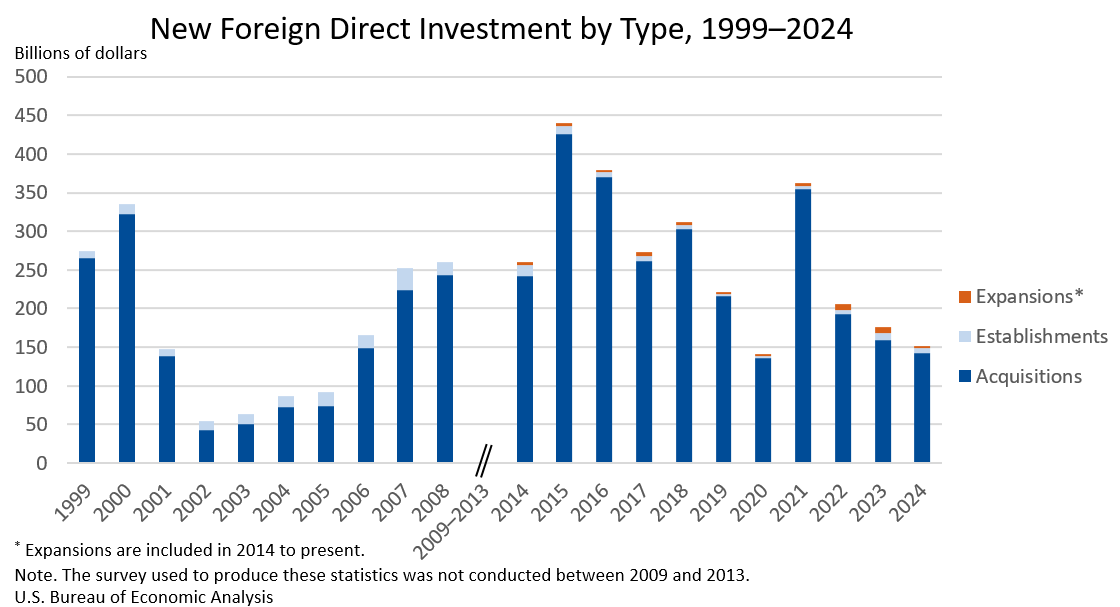Bureau of Economic Analysis
New Foreign Direct Investment in the United States, 2024
Expenditures by foreign direct investors to acquire, establish, or expand U.S. businesses totaled $151.0 billion in 2024, according to preliminary statistics released today by the U.S. Bureau of Economic Analysis. Expenditures decreased $24.9 billion, or 14.2 percent, from $176.0 billion (revised) in 2023 and were below the annual average of $277.2 billion for 2014–2023. As in previous years, acquisitions of existing U.S. businesses accounted for most of the expenditures.
Principal Federal Economic Indicators
Noteworthy
- 2025 News Release Schedule
- Innovation at BEA
- 2025 Annual Updates
- New! Services Trade Data for More Countries
- Data Tool: Trade in Value Added
- Distribution of State Personal Income
- Updated: RIMS II Regional Multipliers
- Arts and Culture
- Space Economy
- FDI Now in State BEARFACTS
- Quick Guide: Price Indexes
The Latest
U.S. Current-Account Deficit Widens in 2022
The U.S. current-account deficit, which reflects the combined balances on trade in goods and services and income flows between U.S. residents and residents of other countries, widened by $97.4 billion, or 11.5 percent, to $943.8 billion in 2022. The widening primarily reflected expanded deficits on goods and on secondary income that were partly offset by an expanded surplus on primary income. The 2022 deficit was 3.7 percent of current-dollar…
U.S. Current-Account Deficit Narrows in 4th Quarter 2022
The U.S. current-account deficit, which reflects the combined balances on trade in goods and services and income flows between U.S. residents and residents of other countries, narrowed by $12.2 billion, or 5.6 percent, to $206.8 billion in the fourth quarter of 2022. The narrowing primarily reflected a reduced deficit on secondary income. Also contributing was an expanded surplus on services. The fourth-quarter deficit was 3.2 percent of…
U.S. International Transactions, 4th Quarter and Year 2022
The U.S. current-account deficit narrowed by $12.2 billion, or 5.6 percent, to $206.8 billion in the fourth quarter of 2022, according to statistics released today by the U.S. Bureau of Economic Analysis. The revised third-quarter deficit was $219.0 billion. The fourth-quarter deficit was 3.2 percent of current-dollar gross domestic product, down from 3.4 percent in the third quarter.
BEA Feasibility Study Report Explores Measuring the U.S. Bioeconomy
This is the executive summary from a new BEA feasibility study report on measuring the bioeconomy.
Updated Statistics Measure Foreign and Domestic Content Embedded in U.S. Exports
BEA today updated and expanded prototype statistics that look more deeply into U.S. exports, revealing the mix of foreign and domestic content used to make exported goods and services.
For example, a tire manufactured in Ohio and sold in Canada might be made with rubber from China and steel belting from Mexico. Traditional trade statistics can’t separate the foreign inputs, like the tire’s rubber and steel, from the overall value of U…
Arts and Culture Economy Grows 13.7 percent in 2021
Arts and cultural economic activity, adjusted for inflation, increased 13.7 percent in 2021 after decreasing 4.8 percent in 2020, according to statistics released today by the Bureau of Economic Analysis. By comparison, the broader economy, as measured by real gross domestic product, increased 5.9 percent in 2021 after decreasing 2.8 percent in 2020.
Arts and cultural economic activity accounted for 4.4 percent of U.S. GDP, or $1.02…
Arts and Cultural Production Satellite Account, U.S. and States, 2021
The Arts and Cultural Production Satellite Account released today by the Bureau of Economic Analysis (BEA) shows that arts and cultural economic activity, adjusted for inflation, increased 13.7 percent in 2021 after decreasing 4.8 percent in 2020. By comparison, the broader economy, as measured by real gross domestic product (GDP), increased 5.9 percent in 2021 after decreasing 2.8 percent in 2020. Arts and cultural economic activity accounted…
2022 Trade Gap is $945.3 Billion
The U.S. international trade deficit increased from $845.0 billion in 2021 to $945.3 billion in 2022 (revised), as imports increased more than exports. The goods deficit increased $100.7 billion to $1.19 trillion, and the services surplus increased $0.5 billion to $245.7 billion. The goods and services deficit was 3.7 percent of current-dollar gross domestic product in 2022, up from 3.6 percent in 2021.
January 2023 Trade Gap is $68.3 Billion
The U.S. international trade deficit increased from $67.2 billion in December (revised) to $68.3 billion in January, as imports increased more than exports. The goods deficit decreased $0.6 billion to $90.1 billion, and the services surplus decreased $1.7 billion to $21.8 billion.
U.S. International Trade in Goods and Services, January 2023
The U.S. monthly international trade deficit increased in January 2023 according to the U.S. Bureau of Economic Analysis and the U.S. Census Bureau. The deficit increased from $67.2 billion in December (revised) to $68.3 billion in January, as imports increased more than exports. The goods deficit decreased $0.6 billion in January to $90.1 billion. The services surplus decreased $1.7 billion in January to $21.8 billion.




